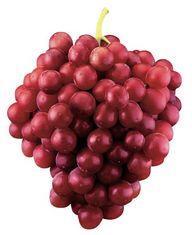
A projected shortfall in Thompson Seedless exports did not materialise in the first two months of Chile’s export season because of an earlier-than-usual harvest in the Region IV northern growing area. But growers and analysts expect the shortfall to be felt later in the season - a mixed blessing for the market and Chile’s exporters, that is likely to boost prices throughout the season.
Volumes of the increasingly popular Red Globe and Crimson Seedless exports will be up, and prices for all of Chile’s table grape varieties will be helped by reduced table grape stocks in the two most important market destinations for Chile’s fruit: the US and Europe.
There has been a notable switch in consumer preference from white to red seedless in recent seasons. Thompson Seedless, previously Chile’s most important export variety, has been outstripped in recent seasons by Red Globe, while the Crimson Seedless variety is growing fast in terms of popularity.
Whatever the variety though, Chile’s growers and exporters are upbeat about their 2003-2004 prospects. “The Thompson volumes are a bit off, while the Red Globe and Crimson volumes are normal,” says Francisco Correa, trade director at Exportadora Ben David SA (Buin), located in the heart of Chile’s Central Valley. Correa says: “All the table grape varieties will be of very high quality this year, assuming that the weather holds. If we have a good summer, it will be a very good year for our table grapes.”
Sharing Correa’s upbeat appraisal is Alfredo Climenti Jr, the head of the newly formed Agrifruta S.A. (Talagante). “Table grapes from our area are doing well,” he says. “Thompson Seedless volumes are a bit lower that last year, because of a complicated spring due to rain but Red Globes and Crimson Seedless volumes will be very good.”
Isabel Quiroz, an executive with Decofrut, the Santiago-based industry service provider, says: “In the US, the principal market for Chilean grapes, stocks for all the major varieties are significantly down compared to the past three seasons. In Europe, fruit stocks are down, too, because of a very severe summer there. This makes us very optimistic about the results we might expect from this 2003-2004 season.”
Giving substance to the analysis, Quiroz notes that early Chilean grapes shipped to the US market - almost all Thompson Seedless - have averaged about $2 per box more than last season.
Chile’s time in Europe is yet to come, but prices are expected to hold, despite a potential clash in the marketplace with heavy South African volumes, which have also been subject to delays.
Quiroz adds that the projected fall off in Thompson Seedless exports had not been felt through the early part of the season because of earlier-than-normal harvests in Chile’s Region IV.
“For some growers their harvest has been two weeks earlier than last season,” she explains. “Region III table grape exports were, in fact, off by seven per cent compared to last year. But there was a 161 per cent increase through mid-December in Region III grape exports, thus off-setting the region’s overall shortfall - at least temporarily.” The early maturing of the Region IV grapes has slightly stunted the size of the grapes.
Table grapes represent Chile’s most important fresh fruit export. According to the Chilean Exporters Association, Asoex, table grapes accounted for 36.8 per cent of the 1.9 million tonnes of fruit exported in 2002-2003.
While table grape exports to all markets are expected to increase in 2003-2004, Europe is expected to grow as fast as some other markets. “It is not so much that demand in Europe is growing,” explains Quiroz. “The demand has always been there. It’s just that the with the reduced tariffs resulting from the Free Trade Agreement with Europe, and with the excellent exchange rate for the euro, most of our industry is finding it a very, very attractive market to be in.”



